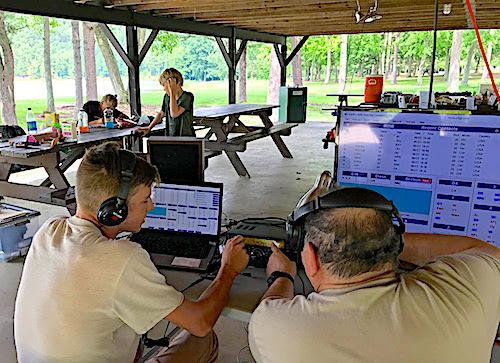
Amateur radio operators to spend 24 hours making ‘contacts’
By Randy Arrington
LURAY — Making “contact” will be the main goal of a small group headed to Lake Arrowhead this weekend to spend 24 hours reaching out to the far corners of North America and beyond. Members of the Page Valley Amateur Radio Club come together during the fourth weekend of June each year to make as many contacts as possible with other “HAM”s to mark the national “Field Day” for the Amateur Radio Relay League (ARRL).
“I can turn on my radio and communicate around the globe,” said N4WIL — also known as Luray resident and local club member, William Baukhages. “I was one of those kids who used to take things apart. I was always fascinated with gadgets.”
A handful of the now two dozen amateur radio operators in the Page Valley formed the local club in 2008 as a 501 3(c) organization. While the Federal Communications Commission (FCC) issues amateur radio licenses to individuals, the ARRL serves as the national umbrella organization overseeing local clubs. The ARRL also has an international union as well. Baukhages has been a member of the local amateur radio club for about a decade.
“Antarctica is the only continent that I have not made contact with,” he said. “It’s kind of a kick in the pants to see the map with dots on all the places I’ve made contacts…Japan, New Zealand, Asia, Africa…Ukraine…”
This weekend over 24 consecutive hours — from 2 p.m. on Saturday, June 22 through 2 p.m. on Sunday, June 23 — members of the Page Valley Amateur Radio Club expect to make “hundreds” of contacts with other amateur radio operators throughout the U.S. and Canada. Baukhages says it’s not uncommon to reach Europe as well — but that’s just with voice-to-voice communications that require a larger bandwidth. Morse Code, a common method of long-distance communication, requires less band width and can travel much farther.
Yet, in a day and age in which everyone’s laptop, or even their phone, can support “face-to-face” communication from almost anywhere in the world…why would some still try to talk to each other over the radio?
“In addition to the shared interest and the community around it…amateur radio also has an emergency radio aspect to it,” Baukhages said. “When Puerto Rico was devastated, FEMA worked with amateur radio operators sent to Puerto Rico to help…everything was wiped out, all of their infrastructure…amateur radio operators were the backbone of communication when Puerto Rico recovered from the storm.”
K4PMH also understands its potential role as a communications back-up in a potential local crisis in the Page Valley. The official call letters for the local radio club were derived from its origins at Page Memorial Hospital (PMH), where the club formed.
Valley Health has since allocated funds to get its own amateur radio equipment at each of its six hospitals in Virginia and West Virginia, including Page Memorial in Luray. In fact, a larger network of about 14 regional hospitals regularly participate in tests to support back-up communications through amateur radio operators, if the electrical grid (and thus internet service) goes down for an extended time. The move was mandated by FEMA following 9/11, requiring regional healthcare providers to come up with communication contingencies.
The public is encouraged to come out and observe amateur radio operators in action at this Saturday’s “Field Day” at Lake Arrowhead just outside Luray. The national event is aimed at promoting awareness of what they do, and its importance to the community at large. Learn how members can earn a license from the FCC as a technician (Level I – basic privileges in local, close wireless communications), general (Level II – privileges in higher frequency bands reaching much further), and amateur extra (Level III – privileges to all amateur radio bands).
Members can get deep into the “science of radio” and even explain the history of how amateur operators have always played a role behind the scenes, from times of war to times of great discovery and innovation.
The event is free and open to the public — and members are hoping to field a few questions.
“It has always been there, and it’s evolved a lot with technology,” Baukhages said. “Private citizens have been out there pushing the science of radio and communication, and so they have always been a resource.”
For more information about the national Field Day,
visit https://www.arrl.org/field-day
•••
RELATED ARTICLES
Council recognizes Mathews for 45 years of service and other news from Luray




Be the first to comment